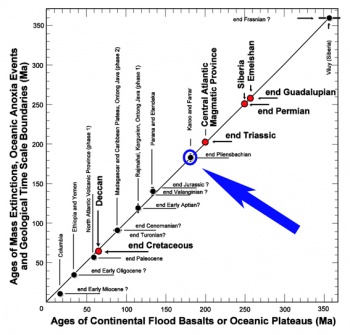ProjectA4
From !khure
Contents |
Project A4: Large igneous provinces, impacts and climate change
French pi: F. Fluteau (with V. Courtillot)
South African pi: G. Marsh
Project Participants
France:
V. Courtillot, F. Fluteau, J. Besse, X. Quidelleur, G. Delpech, C Jaupart, M. Gérard, H. BouquerelSouth Africa:
J. Marsh, M. Watkeys, M. Klausen, A. Duncan, plus one or two Msc or PhD students to be determinedProject Summary
The project focuses on detailed flow-by-flow sampling for palaeomagnetic secular variation studies on two well-characterized Karoo volcanic sequences (a) The low-Ti Oxbow sequence of northern Lesotho, and (b) the high-Ti Olifants River sequence of northern Lebombo. Palaeomagnetic measurements will be done at IPGP and will be complemented by K/Ar and 40Ar/39Ar dating (IPGP) and additional geochemical studies (South Africa) where necessary. The project goal is to construct a refined model for the emplacement of the Karoo volcanic sequences with particular emphasis on volumes and duration of eruptive episodes (in particular identification of short large pulses) and their impact on climate modifications with implications for the end-Pliensbachian extinction. This will be compared to the case of the Deccan volcanics and KT mass extinction.
Background
There is considerable debate on the causes of the biological mass extinction events recognized in the Phanerozoic fossil record. There is consensus that extinctions reflect events of dramatic climate change but the underlying causes of the change remain controversial. Correlations between the mass extinctions and large volume volcanic eruptions (Fig. 1 from Courtillot & Renne, 2003) together with known temperature/climate modification effects of some historical eruptions such as Pinatubo (1991-1992) and Laki (1783-1784) are powerful arguments for a volcanic cause of many of the extinction events. To strengthen and test this hypothesis, large volcanic events have to be investigated in detail to establish (a) the precise timing of the volcanism, (b) volume-duration relationship during the volcanic event and (c) climate change modelling. Detailed results from one such study (Chenet et al, in press) on the Deccan Flood basaltic sequence, which correlates with the large extinction event at the K-T boundary, have shown that flow-by-flow palaeomagnetic sampling of well-characterized stratigraphic sequences allow geomagnetic secular variation data to be recovered from the lava flows. The secular variation can be used as a time proxy which has allowed considerable refinement of the details of the emplacement history of the volcanic sequence, in particular volume-duration relationships. Together with data from red boles intercalated in the lava sequence, results indicate that the Deccan was emplaced as a small number of discrete large-volume short-lived pulses without significant quiescence between them. Gas emissions (largely SO2) of each pulse are of the same order as those proposed for the Chixculub impact, the rival hypothesis for the K-T extinction. These data are strongly suggestive of Deccan volcanism having a significant impact on Earth's climate.
The coincidental eruption of the Deccan sequence with the occurrence of the Chixculub impact indicates that it is crucial to validate the hypothesis arising from the Deccan results of Chenet et al.(in press) with a similar study in another large continental flood basalt sequence. It is proposed to do so with the Karoo flood basalt sequence of southern Africa (Fig. 2). Outcrop remnants of the Karoo volcanic sequence (largely mafic), as well as intrusions, occur over an area >2.5 * 106 km2 with lava sequences exceeding 1 km in thickness in many places. These eruptions tapped two major mafic magma systems - a low-Ti system in the south and a high-Ti system in the north. Eruptive volumes are of similar magnitude to those of the Deccan (total 2x106 km3). Modern age dating (largely 40Ar/39Ar) indicate that the volcanic sequence was emplaced over a short time at about 180-183 Ma (Duncan et al, 1997; Jourdan et al., 2004) which broadly correlates with the extinction event at the Pliensbachian-Toarcian boundary. Detailed geochemical studies have established a well-defined geochemical stratigraphy for all major lava remnants and correlations between them (Fig. 3 - Marsh et al., 1997; Sweeney et al, 1994; Klausen et al., 2005 and Duncan & Marsh, unpubl.). A palaeomagnetic reversal stratigraphy has been well-defined for the Lesotho remnant, and tentatively defined in the Lebombo sequence (Hargraves, et al.,1997). As a first step of the prposed program, we have started a detailed flow-by flow sampling for secular variation studies similar to those of Chenet et al.(in press) in the Deccan in the Naude‟s Nek section of southern Lesotho in November 2006 and samples are currently being processed. Thus the Karoo Province has been sufficiently well-characterized for a focussed palaeomagnetic study to yield meaningful results.



